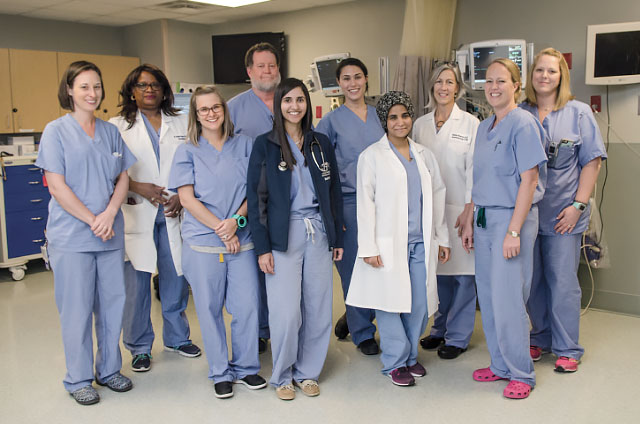Robyne Doyle with her daughters, Emerson and Piper.
When Robyne Doyle was 48, she was diagnosed with breast cancer and underwent a double-mastectomy with reconstruction surgery at GW Hospital. Her primary concern was getting back to her kids, who were 13 and 8 at the time.
She had enjoyed a long career as an ICU nurse at GW Hospital, so she knew firsthand how difficult recovery can be. “I told my kids I’d be in bed for five days and I’d be in a lot of pain,” she recalls. Then her anesthesiologist told her about nerve block therapy for pain relief, and she decided to give it a try.
The paravertebral nerve block involves placing a catheter about one inch off- center of the back, and hooking it to a pump that continually administers numbing medication during the first crucial days of recovery, explains anesthesiologist Paul F. Dangerfield, MD, director of acute and chronic pain services and assistant professor of anesthesiology at the George Washington University School of Medicine and Health Sciences. The medication is contained in a ball attached to the catheter, which patients wear in a fanny pack strapped around their waist.
This therapy is offered in conjunction with an anti-inflammatory medicine and a very low dose of Valium to relax the muscles, Dr. Dangerfield explains. By using this multi-modal approach, the goal is to minimize the use of narcotics and at the same time improve the quality of pain control, he says.
“This is really targeted pain relief, very similar to an epidural, but instead of going into the mid-line of the back, it’s just off to the side of the backbone,” explains anesthesiologist Marian Sherman, MD, who serves as assistant professor of anesthesiology and critical care medicine at the George Washington University School of Medicine and Health Sciences, along with anesthesiologist Anna Katharine Hindle, MD.
“It can get you through that first really uncomfortable time,” says Dr. Hindle. “For most patients, it really does minimize the amount of other medications they need to take.”
Robyne spent two days in the hospital before returning home from her surgery with her fanny pack. Throughout her recovery she says she never had any pain. “I was able to get to the bus stop to pick up my kids just 48 hours after surgery. I’ll never forget their smiles when they saw me standing there. They just wanted things to be normal. It was a gift to show them that I was okay.”
With advances in care, GW Hospital can now more precisely place nerve blocks using ultrasound guidance. This can support greater success rates and patient satisfaction, Dr. Dangerfield says. Nerve block therapy can be used for a wide variety of conditions, from broken ankles to knee or shoulder surgery.
Ultimately, it’s about giving patients safe, effective choices. Educating them about the different therapies available is the first step. “On the day of surgery, it really is the patient’s choice,” says Dr. Hindle.
Opioids and Surgery
The multidisciplinary pain management team at GW Hospital develops individualized treatment plans to help manage pain safely and effectively.
People are increasingly aware of the risk of addiction when taking opioids, which are classified as narcotics and can be prescribed for pain relief. A link between surgery and long-term opioid use was found in a national study published in JAMA Surgery.*
In the study, researchers found that about six percent of people who hadn’t been taking opioids before their operation, but were prescribed the drugs to ease their post-surgery pain, were still getting the drugs three to six months later.
GW Hospital is committed to reducing the risk of opioid addiction among patients, while still providing effective pain relief. Offering a multi-modal approach to pain management is an important way the hospital is working to achieve this goal.
*Published online April 12, 2017.


